Flowers are an essential part of decorating the house during festive occasions. However, some types of flowers can cause allergies for those with sensitive allergies. If you suddenly experience allergies, headaches, itching, etc., you should check if it is due to the 5 types of flowers mentioned in the following article!
1 5 types of flowers commonly used during Tet that can cause allergies
Chrysanthemums
are the most popular flowers during Tet. With their vibrant yellow color, Chrysanthemums symbolize longevity and good luck in the new year, making them a popular choice for decoration. Additionally, Chrysanthemums are also a symbol of health, vitality, and longevity in East Asian cultures.
Chrysanthemums contain allergenic compounds such as sesquiterpene lactones, which are present in large amounts on the surface of the flowers and leaves, easily becoming airborne and coming into contact with the human body.
When these allergens come into contact with the human body, they can cause hives, rashes, itching, which can last for a few hours or longer.
 Chrysanthemums
Chrysanthemums
Lilies
are also a popular choice for Tet decorations. Lilies represent purity, luck, freshness, and brightness. Vietnamese people believe that by having lilies in the house, they will have a lucky, successful, and happy new year.
The reason many people are allergic to lilies is not due to pollen but the strong fragrance of this flower. The fragrance of lilies can cause irritation, headaches, and even nausea when inhaled in large amounts.
 Lilies
Lilies
Tulips
are known for their associations with love, freshness, and purity. Although not common in Vietnam, tulips are becoming increasingly popular for Tet decorations as they come in various colors, each with its unique meaning.
Red symbolizes love and passion, yellow represents warmth and happiness, while white signifies purity and new beginnings. For these symbolic meanings, people hope to have a good and colorful start to the new year by having tulips in their house during Tet.
However, you need to be careful with tulip bulbs as they can cause allergies when in contact with the skin. Handling tulip bulbs can cause itching, redness, hives, blistering, and even brittle or cracked nails.
 Tulips
Tulips
Hydrangeas
are often used for Tet decorations as they are believed to bring wealth, luck, prosperity, and vitality to the house. Hydrangeas represent elegance and charm.
However, hydrangeas can cause allergies if touched or ingested, especially for people with sensitive skin. This is because hydrangeas contain a toxin called hydrangin which can be converted into crystal calcium oxalate in the intestines, causing discomfort, nausea, diarrhea, difficulty breathing, weakness, etc.
 Hydrangeas
Hydrangeas
Primroses
symbolize hope, purification, and rejuvenation. They bloom at the beginning of spring, marking the end of the cold winter. Many people believe that primroses bring luck and freshness to the house at the beginning of the year.
However, despite their beauty, primroses can cause allergies with symptoms such as allergic rhinitis, contact dermatitis, hives, and asthma. These allergic reactions are due to alkaloids, including masonin and homolycorin, which can cause sensitization when combined with calcium oxalate crystals.
 Primroses
Primroses
2 What to do to safely display Tet flowers?
- Avoid choosing flowers with allergenic pollen such as chrysanthemums, roses, orchids, etc., especially if someone in the house has a history of allergies to these flower pollens.
- Use artificial or dried flowers to minimize the risk of allergic reactions to flower pollen. However, regular cleaning is necessary to prevent mold growth.
- Avoid using flowers with strong fragrances.
- Place flowers in well-ventilated areas to minimize the accumulation of allergens.
- Regularly clean around the flower arrangement to reduce dust and pollen accumulation. Remove withered or damaged flowers as they can become breeding grounds for bacteria and mold, increasing the risk of allergies in people with a history of allergies.
 What to do to safely display Tet flowers?
What to do to safely display Tet flowers?
Above are some types of flowers that can cause allergies in people with sensitive allergies. Hopefully, the information above helps you identify the source of allergies and ways to address them!
Source: Bao Phu Nu Viet Nam














